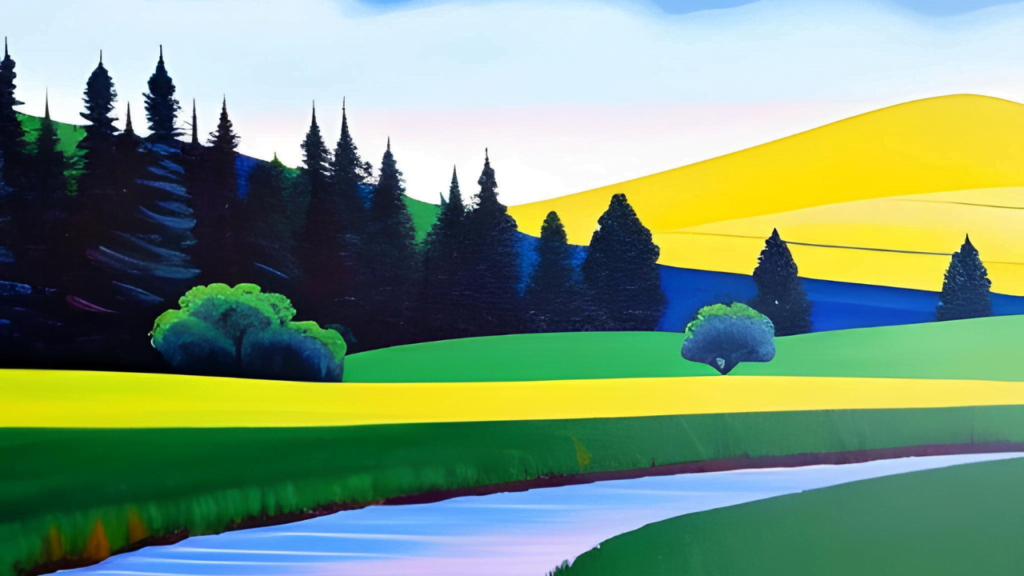
Discover the art of painting landscapes with tempera paint. Follow our expert guide to create stunning landscapes using tempera paint, complete with step-by-step instructions, tips, and techniques.
Landscape painting with tempera offers a beautiful and expressive way to capture the natural world on canvas. Whether you’re a beginner or an experienced artist, this guide will walk you through How to Paint a Landscape with Tempera Paint and the process of creating a captivating landscape using tempera paint.
Materials You’ll Need
Before you start, gather these essential materials:
- Tempera Paint: Choose various colors to capture the landscape’s diversity.
- Canvas or Paper: Use a suitable surface for your tempera painting.
- Paintbrushes: Different brush sizes for various details.
- Palette: To mix and blend colors.
- Water and Cloth: For cleaning brushes and thinning paint.
- Easel: Provides a comfortable painting setup.
Step-by-Step Guide on How to Paint a Landscape with Tempera Paint

1. Select Your Landscape
Choose a reference image or paint from life, focusing on elements like mountains, rivers, trees, and skies.
2. Prepare Your Palette
Squeeze out the tempera paint colors you’ll need onto your palette. Start with primary colors and mix as needed to achieve your desired shades.
3. Sketch the Composition
Using a light pencil, lightly sketch the basic shapes of your landscape on the canvas. This serves as a guide for your painting.
4. Block in the Background
Start with the sky and distant elements. Use broad brushstrokes and light colors to establish the background.
5. Build the Middle Ground
Add more detail to the middle-ground elements, such as hills, trees, and bodies of water. Use a combination of larger and smaller brushes for different textures.
6. Add Foreground Details
Focus on the foreground, adding intricate details like rocks, grass, and plants. Use smaller brushes and finer strokes for realism.
7. Blend and Layer
Use the technique of layering and blending to create depth and dimension. Apply translucent layers of paint to achieve a rich and nuanced appearance.
8. Highlights and Shadows
Add highlights with lighter shades and shadows with darker colors. Pay attention to the direction of light for realistic effects.
9. Final Touches
Step back and assess your painting. Make any necessary adjustments to enhance the overall composition.
Tips and Techniques
- Texture Variation: Experiment with brush strokes to achieve textures like rough tree bark or soft clouds.
- Color Mixing: Tempera paints can be mixed to create a wide range of colors. Start with a small amount and gradually mix to achieve the desired shade.
- Dry Brushing: Lightly dipping your brush into the paint and then wiping most of it off before applying creates a dry brush effect, ideal for adding texture.
Frequently Asked Questions
Can I use tempera paint on canvas?
Yes, you can paint with tempera on canvas, but preparing the canvas with a suitable primer is essential to prevent paint from flaking.
How do I achieve realistic water reflections?
Paint the water surface with the colors of the surroundings, adding ripples and reflections of nearby objects.
Is tempera paint permanent?
Tempera paint can be quite durable, especially when properly sealed with a varnish. However, it might not be as permanent as oil paints.
Can I blend colors in tempera like I can with oils?
While blending in tempera is possible, it requires a different technique due to the quick-drying nature of tempera. Work swiftly and layer colors for seamless blending.
What’s the best way to paint realistic trees?
Start with a base color, add texture with dry brushing, and then layer on highlights and shadows to create a three-dimensional effect.
Can I use tempera paint for plein air painting?
Yes, tempera can be used for plein air painting, but keep in mind it’s faster drying time than oil paints.
Conclusion
Landscape painting with tempera paint allows you to capture the beauty of nature with vivid colors and intricate details. By following this step-by-step guide, experimenting with techniques, and embracing the unique qualities of tempera, you’ll create stunning landscapes that showcase your artistic talent.
Remember, practice is key. As you gain experience, you’ll develop your style and discover new ways to express your artistic vision through tempera painting.
Get in Touch: For professional assistance with your plumbing needs in the Fife council area, contact Fife Trades. Visit our website fifetrades.co.uk to learn more about our services or send us a message at fifetrades@gmail.com. We’re here to help you keep your plumbing running smoothly.
